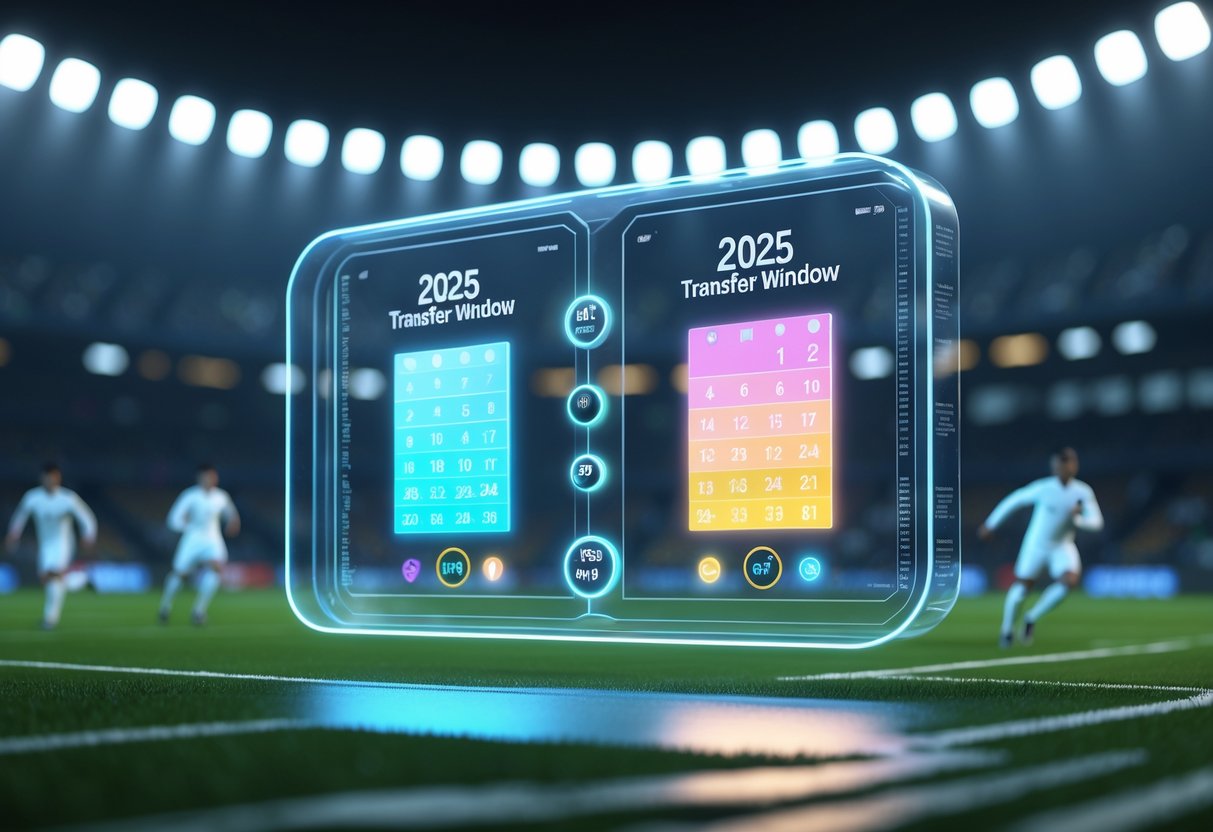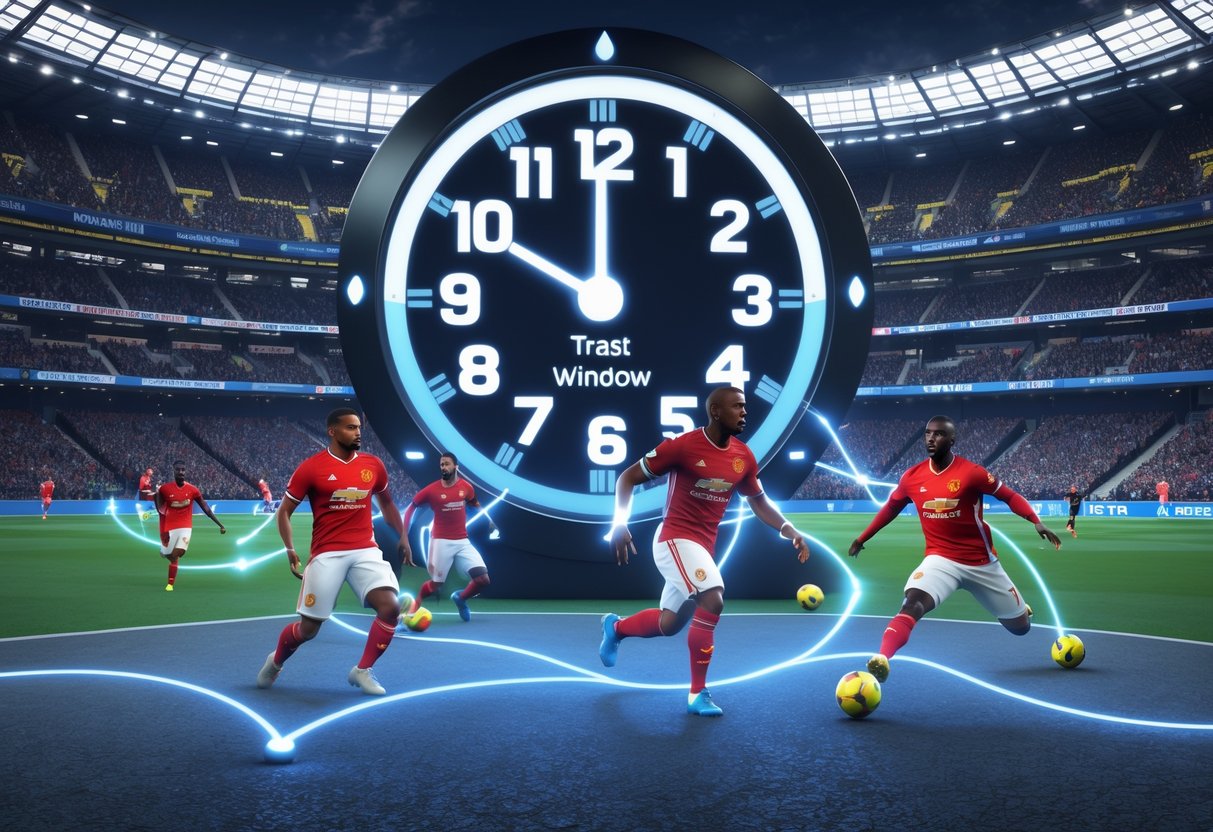Transfer Window Length: Rules, Timing & Impact Explained
Updated On: August 23, 2025 by Aaron Connolly
Defining Transfer Window Length

Transfer window length basically defines when professional football clubs can buy and sell players. FIFA lays out the rules, but each league picks the exact dates, which really shapes how clubs approach their squad changes.
Official Duration in Professional Football
Most professional football leagues stick to two transfer windows each year. The summer window usually lasts about 12 weeks, starting in June or July.
The winter window is way shorter—just four weeks in January.
In the Premier League, the summer window usually opens on June 10th and shuts on August 31st. That gives clubs nearly three months to get deals done.
January’s window runs from the 1st to the 31st.
Different leagues pick their own dates, but they stay inside FIFA’s guidelines. For example, La Liga and Serie A often close their windows before the Premier League does.
This sometimes causes headaches when clubs want to sign players from abroad.
Key window periods:
- Summer: 10-12 weeks (main trading period)
- Winter: 4 weeks (emergency signings)
- Emergency: Special circumstances only
Impact of FIFA Regulations
FIFA sets the global rules for how long transfer windows can last. These rules keep things fair across international football.
If FIFA didn’t step in, some leagues might keep their windows open longer and get an unfair edge.
FIFA only allows two registration periods per country each year. The main one can’t go over 12 weeks, and the mid-season window maxes out at four weeks.
These rules protect player contracts and help keep the competition balanced. They also fit around big tournaments like the World Cup and European Championships.
When major tournaments come up, FIFA sometimes changes window dates.
FIFA’s core rules:
- Maximum two windows per year
- Summer window: 12 weeks maximum
- Winter window: 4 weeks maximum
- Must fit league calendars
Importance in Club Operations
Transfer window length really shapes how clubs plan their squads. A longer window means more time to negotiate, but it can make things unpredictable for managers.
Shorter windows force clubs to make decisions fast, but they don’t leave much room for haggling.
Clubs have to plan months ahead and can’t sign new players outside the windows, even if they’ve got injuries. It’s a bit brutal, honestly.
The window length also affects player values and what agents charge. Longer windows usually mean clubs can negotiate better deals.
When the window’s about to slam shut, prices can get a bit wild.
The best clubs spot their targets early and move fast when the window opens. They don’t hang around.
Key Dates of the 2025 Transfer Windows

The 2025 transfer windows have a weird schedule because of the FIFA Club World Cup. The Premier League summer window opens in two phases and closes on September 1st.
Winter windows still last about four weeks, while the summer period stretches to 16 weeks.
Premier League Opening and Closing Times
In 2025, the Premier League summer transfer window splits into two parts. The first phase runs from Sunday 1 June to Tuesday 10 June at 19:00 BST.
Then, there’s a six-day break before things start up again on Monday 16 June.
The window finally closes on Monday 1 September at 19:00 BST.
So, you get two phases:
- Phase 1: 1-10 June (10 days)
- Phase 2: 16 June – 1 September (11 weeks)
The total length matches previous years, more or less. Clubs can register players in both phases.
Special Club World Cup Registration Period
FIFA set up a special registration period for the expanded Club World Cup. That’s why the Premier League summer window opens earlier in June.
Clubs playing in the tournament need to sign players before it kicks off. The early window from 1-10 June gives them that chance.
Other Premier League clubs can use this early period too, but honestly, most deals happen in the main phase after 16 June.
This early window is just for 2025, thanks to the Club World Cup’s new format.
Winter and Summer Transfer Windows Compared
The winter window is always short—just four weeks in January. The summer window for 2025 lasts about 16 weeks, following FIFA’s 16-week-per-year rule.
| Window | Duration | Typical Activity |
|---|---|---|
| Winter | 4 weeks | Emergency signings, loan deals |
| Summer | 16 weeks | Major transfers, squad rebuilding |
Summer windows are busier and see more big-money moves. Winter is more about plugging gaps.
The 2025 summer window’s split structure doesn’t change its total length. Clubs still get the full 16 weeks across both phases.
Transfer Window Length Across Major Leagues

Transfer window lengths aren’t the same everywhere. Most European leagues stick to 12-week summers and 4-week winters, but some leagues tweak their schedules for tournaments or local reasons.
Premier League vs Other Top European Leagues
The Premier League uses the same basic transfer window structure as other big European leagues. Summer windows last about 12 weeks, and winter windows go for around 4 weeks.
La Liga, Serie A, and Ligue 1 run on almost the same timelines as the Premier League. This makes it easier for clubs like Real Madrid to negotiate deals with teams from other leagues.
Now, all top five European leagues close their summer windows at the same time. That’s made transfers a lot less messy.
Winter windows in these leagues usually open in early January and close by early February. The short window keeps mid-season moves to a minimum.
Global Variations and Exceptions
Major League Soccer does things differently because their season runs from spring to autumn. In 2025, the MLS primary window goes from 31st January to 23rd April, and the secondary window starts 24th July.
Some leagues changed their 2025 summer windows because of the Club World Cup. These tweaks shifted the usual opening and closing dates.
Saudi Arabian leagues have their own schedules. Their transfer periods often last longer than Europe’s, mainly to fit in more regional moves.
Smaller European leagues sometimes stretch or shrink their windows a bit. But most try to line up with the big leagues so international transfers don’t get complicated.
Rules and Regulations Shaping Window Length

FIFA sets the global rules for transfer windows, but each league tweaks them to fit their own calendars. The Premier League, like other top divisions, tries to balance FIFA’s requirements with their own scheduling needs.
FIFA Mandate on Transfer Periods
FIFA tells all member associations to have two transfer windows per year. The main summer window can’t last longer than 12 weeks, and the winter window can’t go past four weeks.
These rules kicked in back in 2002 to stabilize football. FIFA wanted to stop smaller clubs from losing players halfway through the season.
They also wanted fans to know when squads could change.
Summer Transfer Window Requirements:
- Maximum 12 weeks duration
- Must fit with the start of the domestic season
- Can’t overlap with competitive matches
Winter Transfer Window Rules:
- Maximum 4 weeks length
- Usually runs January to early February
- Must not mess with league schedules
FIFA lets leagues with different seasonal patterns adjust their windows. Southern Hemisphere countries can line up their windows with their own summer or winter.
But the total window lengths always stay the same.
League-Specific Adjustments
The Premier League works inside FIFA’s rules but picks its own dates. England’s summer window usually goes from mid-June to early September, giving clubs about 10-11 weeks.
For a while, Premier League clubs wanted the summer window to close before the season started. That rule lasted from 2018 to 2020, but clubs didn’t like it—they felt it put them at a disadvantage in Europe.
So, the league went back to FIFA’s standard timing.
Premier League Window Timing:
- Summer: Usually 10-11 weeks (June-September)
- Winter: Exactly 4 weeks (January)
- Closes at 11pm GMT on deadline day
Other big leagues do pretty much the same, with small differences. La Liga and Serie A usually close their summer windows on August 31st, while the Bundesliga sometimes runs a bit into September.
The Championship and lower English divisions follow the same windows as the Premier League. This keeps things simple when players move between levels.
Effects on Clubs and Squad Planning

Transfer window length really puts clubs under pressure to get their squads sorted before the deadline. Teams have to juggle last-minute deals and the 25-man squad registration rules.
Deadline Day Strategies
Deadline day always ramps up the stress for Premier League clubs trying to finish squad planning. Manchester United, Arsenal, and Chelsea often wait until the last minute for big signings.
But this approach can backfire. Clubs sometimes panic and overpay for players who don’t fit their style.
We’ve all seen those deadline day panic buys when teams realize they’ve got holes in the squad.
Smart clubs do it differently:
- They handle most business early in the window
- They keep backup targets ready
- They set budget limits before the chaos hits
Liverpool and Manchester City usually avoid the last-minute rush. They spot their targets early and negotiate calmly.
Late signings can be tricky. New players sometimes join just days before the season, miss pre-season, and struggle to settle in.
25-Man Squad Rules
Premier League clubs have to register exactly 25 players over age 21. This rule drives every transfer decision.
The 25-man squad breaks down as:
- Max 17 non-homegrown players
- At least 8 homegrown players (clubs can register fewer if they want)
- Unlimited under-21 players
Manchester City often runs into trouble with these limits because their squad is so international. They have to loan out or sell players before bringing in new signings.
Arsenal and Chelsea use the rules to their advantage. They promote academy players to fill the homegrown quota and save on transfer fees.
The registration deadline comes a few days after the transfer window closes. Clubs get a short window to finalize their lists and drop anyone who didn’t make the cut.
Summer Transfer Window: Detailed Timeline

The summer 2025 transfer window splits into two phases because of the FIFA Club World Cup. The first period runs from June 1-10, then the main window goes from June 16 to September 1.
Early Registration Periods
The early summer window opens on June 1, 2025, but only lasts nine days. This short phase is just for teams playing in the expanded FIFA Club World Cup.
Key dates for the early window:
- Opening: Sunday, 1 June 2025
- Closing: Tuesday, 10 June 2025
- Duration: 9 days only
This window lets clubs register new players for the Club World Cup. Most Premier League teams won’t use it unless they’ve qualified.
The early period ends on June 10. Between June 11-15, the window’s closed and no transfers happen.
Quick tip: Check if your club’s in the Club World Cup to see if they’ll be busy in early June.
Main Phase and Closing Hour
The main summer transfer window opens back up on June 16, 2025. This is when most Premier League transfer action happens.
Main window timeline:
- Opening: Monday, 16 June 2025
- Closing: Monday, 1 September 2025
- Duration: About 11 weeks
The Premier League usually closes the summer window at 11pm UK time on deadline day. Clubs have to get all their paperwork in before that.
Heads up: If you submit late, even if talks started earlier, your deal’s off.
The total window can’t go past 89 days across both phases. This keeps the window inside FIFA’s rules and fits the Club World Cup schedule.
Winter Transfer Window: Overview and Differences

The winter transfer window only lasts a month, usually from January to February. Clubs scramble to buy and sell players during this short burst of activity.
Most teams use this window to patch up sudden problems. Maybe someone’s injured, or a weak spot needs shoring up fast. Sure, you’ll see a big-money deal here and there, but it’s not as wild as the summer.
Key differences between winter and summer windows:
| Aspect | Winter Window | Summer Window |
|---|---|---|
| Duration | 1 month | 3 months |
| Primary purpose | Fix problems, replace injured players | Major squad rebuilds |
| Transfer spending | About 25% of total annual spending | About 75% of total annual spending |
| Club approach | Quick fixes, tactical moves | Long-term planning |
The Premier League lines up with this general pattern. Clubs sometimes gamble more in winter, desperate for results in the back half of the season.
Winter window characteristics:
- Shorter timeframe ramps up the pressure for deals
- Higher prices pop up because sellers know time’s tight
- Loan deals happen more often than permanent moves
- Squad players move more than the big stars
Clubs try to use winter windows in clever ways. Some offload unhappy players, others bring in old hands for a tough run of games.
Negotiations move fast—there’s barely time to breathe, let alone plan every detail.
Teams fighting relegation sometimes spend big in January. Clubs chasing trophies try to add depth for a crowded fixture list.
Significance of Transfer Window Length for Players

How long these windows stay open really shapes players’ options and contract situations. Players deal with different rules depending on their contract status, and free agents get special treatment. If you’re outside the window, your options shrink fast.
Free Agents and Registration Rules
Free agents work under different rules than contracted players. They can talk to clubs all year since they’re not tied down.
But registration deadlines still matter. Free agents have to finish registration before the window closes to actually play.
Players like Christian Eriksen have taken advantage of this. When his contract ran out, he could sign outside the usual periods.
The registration process usually includes:
- Medical checks
- Signing the contract
- League approval
- Getting a work permit if it’s an international move
As the window ticks down, free agents feel the pressure. Clubs often wait until the last minute, which can leave players scrambling for options.
Opportunities for Transfers Outside the Window
Players can’t usually move clubs outside the official windows. There are rare exceptions, like emergency loans.
If a club faces a goalkeeper crisis, they might get special permission. But these emergency moves have strict rules and don’t last long.
Lukasz Fabianski made a mid-season move thanks to these emergency rules when his club needed a keeper.
Some leagues use different timings:
- Summer windows: June to August or September
- Winter windows: January only
- Emergency loans: Only for goalkeeper injuries
Players can get released from contracts outside windows, but they can’t register with a new club until the next window. That leaves some training on their own or joining unofficially.
If you’re under contract, you can’t just force a move outside the window. Clubs hold the cards, which keeps their investments safe but limits player freedom for most of the year.
Clubs and Star Players Influenced by Window Timing

Transfer windows put clubs and players under serious time pressure. The long summer window lets clubs haggle and plan, but January’s quick turnaround means snap decisions that can flip a season on its head.
High-Profile Transfers in Recent Windows
Summer windows always bring the biggest headlines. Manchester City landed Erling Haaland in the 2022 summer window, shaping their season around him.
Real Madrid loves to move early. They announce big signings right at the start to give new players more time to settle. Jude Bellingham’s move is a textbook example.
Recent Window Standouts:
- Viktor Gyökeres joined Sporting CP during a crucial summer
- Benjamin Šeško moved to RB Leipzig early in the window
- Darwin Núñez arrived at Liverpool with plenty of pre-season left
Chelsea and Arsenal have learned to act fast. Chelsea’s move for Enzo Fernández in January showed how deadline stress can drive up prices.
January feels different. Aaron Ramsdale moved mid-season when his club’s goalkeeper situation changed overnight.
Case Studies: Impact on Leading Teams
Liverpool under Jürgen Klopp nailed their timing. They signed Mohamed Salah early in summer 2017, giving him a full pre-season. That early start helped him smash records in his first year.
Manchester City’s success comes from early planning. They pick targets months ahead and move as soon as the window opens. Their signings settle in quickly because of it.
Key Timing Patterns:
| Club | Strategy | Recent Example |
|---|---|---|
| Arsenal | Early summer deals | Declan Rice signing |
| Chelsea | Deadline day activity | Multiple January moves |
| Liverpool | Strategic patience | Waiting for right targets |
Arsenal’s rebuild under Mikel Arteta shows smart use of the window. They snapped up Martin Ødegaard early, so he could integrate before the season kicked off.
Players like Kyle Walker have seen their careers shaped by window timing. His move from Tottenham to City came at the perfect moment for both sides.
Young talents like Bryan Mbeumo and Eberechi Eze have watched their values rise and fall with window cycles and form.
Notable Changes and Trends in Transfer Window Length

Transfer window lengths have changed a lot since 2002. The Premier League’s early closure test and FIFA’s schedule tweaks for new competitions have shaken things up.
Recent Alignments Among Major Leagues
The Premier League tried closing its summer window before the season started in 2018 and 2019. English clubs ended up with less time than their European rivals.
That idea fizzled quickly. By 2020, the Premier League switched back to the usual European deadline. Clubs complained that other leagues could still poach their players after the English window shut.
Key timeline changes:
- 2018-2019: Premier League closed before opening weekend
- 2020-present: Back to 31 August deadline
- Now: Most big European leagues close on 31 August
The January window hasn’t changed much. It’s a tight month everywhere. That short span means clubs do fewer deals and feel more heat.
Clubs sometimes announce signings outside the window, but the player only joins when it reopens. Brighton did this with Diego Gomez in December 2024 for a January 2025 arrival.
Impact of International Competitions
FIFA’s packed tournament calendar keeps pushing at the old window dates. The new 32-team Club World Cup will probably force more flexible registration periods.
Big international tournaments like the Euros and World Cup already mess with summer transfers. Clubs often wait until those finish before finalizing deals.
The expanded Club World Cup may push FIFA to add extra registration periods. That way, clubs could sign players between tournament phases.
Current challenges:
- Longer international tournaments
- More club competitions
- Worries about player fatigue
- Limits on squad sizes
Some leagues are even talking about small emergency windows for injury crises. These wouldn’t mess with the main summer or winter periods but could help clubs in a pinch.
Transfer Window Length: Future Outlook

FIFA keeps looking at tweaks for transfer window timing and length. The game’s changing, and there’s more pressure to adjust windows for fairness and player wellbeing.
Potential Adjustments and Reforms
FIFA has hinted at possible changes to how windows work. The 2025 summer window already shows some of that, with split periods for clubs in the FIFA Club World Cup.
Possible reforms:
- Longer winter windows – Maybe moving the deadline from January to February for more flexibility
- Unified closing times – The 2025 move to a 7 p.m. UK closing time across major leagues is a step in that direction
- Player welfare – Shorter windows could mean less uncertainty for players and their families
European leagues have agreed to close windows together on 1 September 2025. That stops clubs from using staggered deadlines to their advantage.
FIFA now lets clubs register free agents after windows close. That adds some flexibility while keeping the main window structure intact.
Long-Term Impact on Professional Football
Changes to window length will shift how clubs operate. Shorter windows could mean less player power, but longer ones might make squads more stable.
What’s likely to happen:
- Earlier planning – Clubs will have to move faster
- Longer contracts – To avoid constant window drama
- Focus on youth – Less reliance on last-minute signings
Standard closing times across leagues will end the days when, say, Spanish clubs had extra hours to pull off late deals after England’s window shut.
Commercial interests will keep driving changes. Broadcasters want squads set early for promos, and sponsors prefer stable rosters.
Shorter windows might even slow down transfer fee inflation. With less time to haggle, clubs might settle for lower offers instead of risking no deal at all.
Frequently Asked Questions

Transfer window lengths differ a bit between leagues, but the patterns are mostly the same. Most European leagues run summer windows for two or three months and winter windows for just one.
How long does a typical football transfer window stay open?
Most leagues keep the summer window open for around 10 to 12 weeks. That’s usually early June through August or early September.
Winter windows are way shorter. They open on 1 January and close by the end of January or early February.
Premier League and Championship clubs get about 10 weeks in summer. Lower leagues in England follow pretty much the same dates.
What are the specific dates for the summer and winter transfer windows in European football?
The Premier League summer window usually starts in mid-June and finishes at 11pm on 1 September. In 2024, it ran from 14 June to 30 August.
Winter windows open on 1 January for most European leagues. England closes at 11pm on 31 January.
La Liga, Serie A, and Bundesliga stick to similar timelines. Sometimes the exact days shift a little depending on the season’s end.
Can clubs buy and sell players outside of the official transfer windows?
Clubs can’t register new players outside the set windows. All registrations have to happen during those periods.
But clubs can still negotiate and agree deals outside the window. The move just won’t go through until the next window opens.
Free agents are the exception. If you’re out of contract, you can join a club anytime.
Are there any differences in transfer window duration between various football leagues?
Most top European leagues sync up their windows. The Premier League, La Liga, Serie A, and Bundesliga usually start and end together.
Lower divisions usually copy their top league’s dates. The English Championship, for example, matches the Premier League.
Some smaller leagues may tweak their dates. The Scottish Premiership sometimes runs a few days longer than England.
MLS does things differently because of its spring-to-autumn schedule. Their main window runs from February through May.
What rules govern the extension of a transfer window for a particular league or club?
FIFA sets the main rules for transfer windows. Leagues can’t just extend the window for one club unless FIFA gives the green light.
Extensions are rare and only happen in special cases—like natural disasters or political chaos.
Sometimes technical issues with registration systems cause a short extension, but that’s usually just a few hours.
Leagues work with FIFA and UEFA to make sure their windows don’t clash with big tournaments or qualifiers.
How does the transfer window duration impact loan deals for players?
Loan deals stick to the same window restrictions as permanent transfers. Players can only move to new clubs when the window’s open.
Short winter windows make complex loan arrangements tough. Clubs scramble to negotiate terms and get medicals done in time.
Most leagues have scrapped emergency loans outside the window. The Championship held onto this system until it finally ended in 2019.
Clubs need to recall loaned players during transfer windows, too. If the window’s closed, they can’t bring players back mid-season.
